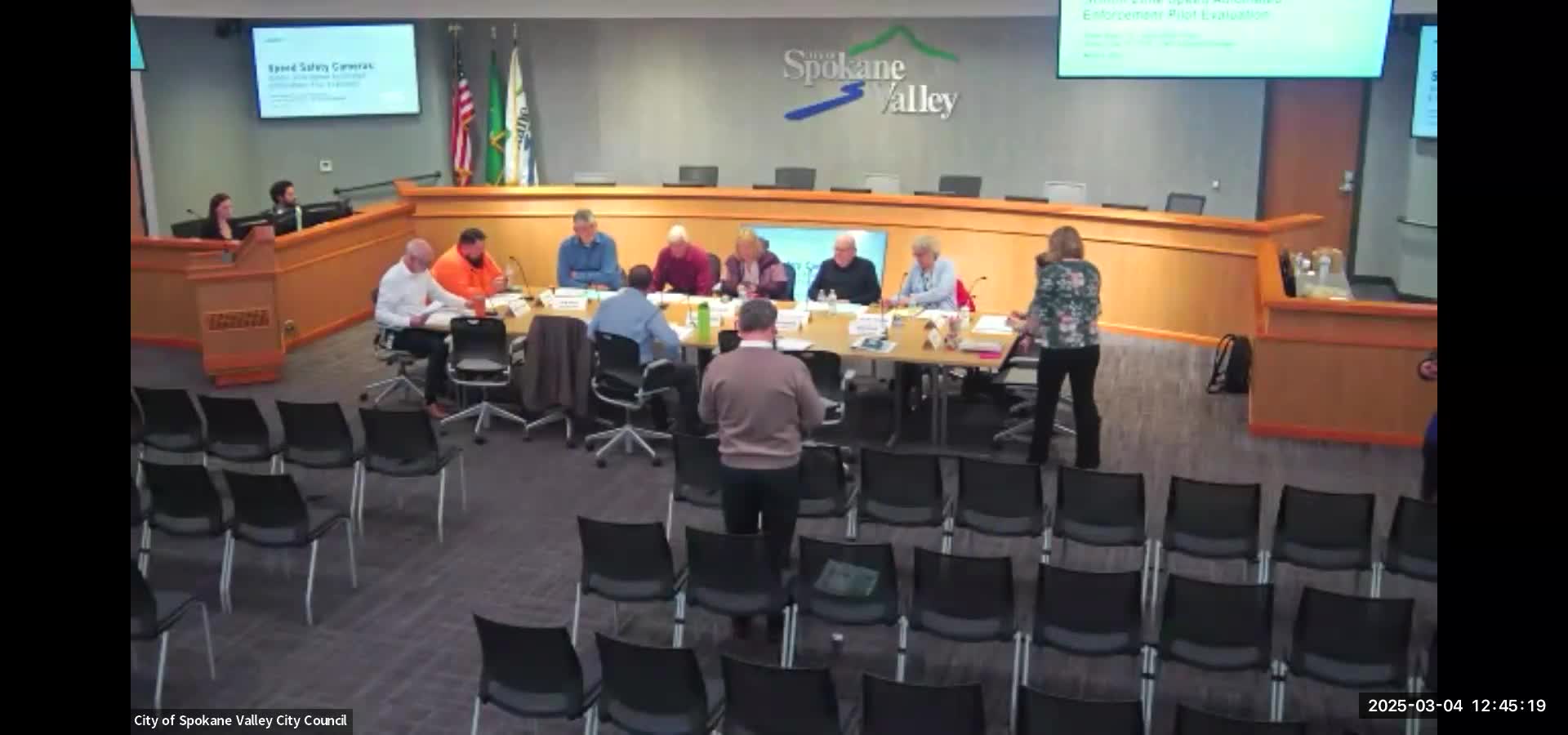Spokane Valley Council discusses school zone speed cameras for traffic safety funding
March 05, 2025 | Spokane Valley, Spokane County, Washington
This article was created by AI summarizing key points discussed. AI makes mistakes, so for full details and context, please refer to the video of the full meeting. Please report any errors so we can fix them. Report an error »

Spokane Valley is taking significant steps toward enhancing school zone safety with the proposed implementation of speed zone cameras. During a special council meeting on March 5, 2025, city officials discussed the potential benefits and logistics of introducing these cameras, which aim to deter speeding in school zones and improve overall traffic safety.
The initiative was sparked by community members Manny and Kendra Rojas, who raised concerns about speeding in school areas. Council members expressed a strong interest in exploring this topic, particularly in light of historical discussions surrounding red light cameras. The primary goal of the speed zone cameras is to increase safety for children and pedestrians, while also generating revenue that could support local law enforcement efforts.
Robert Bacon, a key presenter at the meeting, outlined the framework established by House Bill 2384, which governs the use of these cameras. The bill allows for the capture of license plate images during traffic violations, with strict regulations on data collection to protect driver privacy. Notably, 25% of the revenue generated after four years of operation must be allocated to the state’s transportation safety account.
The council reviewed data from other jurisdictions that have successfully implemented similar systems. For instance, cities like Kirkland and Seattle have reported substantial revenue from their camera programs, which have also led to a significant reduction in speeding violations. The Spokane Valley Police Department provided insights into potential locations for camera installation, highlighting areas with high rates of speeding during school hours.
Council members debated the financial implications of the camera system, including the costs associated with installation and maintenance. Estimates suggest that the city could generate around $440,000 in revenue from three cameras after accounting for operational costs. However, concerns were raised about the sustainability of revenue as speeding violations typically decrease over time once cameras are introduced.
The discussion also touched on the possibility of using generated funds to hire additional traffic officers or implement traffic calming measures in school zones. While the house bill permits the use of revenue for traffic safety improvements, it restricts funds from being used for unrelated purposes.
As Spokane Valley moves forward with this initiative, the council is tasked with determining the best approach to implement the camera system effectively. The next steps will involve further studies on potential locations and a detailed analysis of the financial framework to ensure that the program meets its safety objectives while remaining financially viable. The council's commitment to enhancing school zone safety reflects a proactive approach to community welfare and traffic management.
The initiative was sparked by community members Manny and Kendra Rojas, who raised concerns about speeding in school areas. Council members expressed a strong interest in exploring this topic, particularly in light of historical discussions surrounding red light cameras. The primary goal of the speed zone cameras is to increase safety for children and pedestrians, while also generating revenue that could support local law enforcement efforts.
Robert Bacon, a key presenter at the meeting, outlined the framework established by House Bill 2384, which governs the use of these cameras. The bill allows for the capture of license plate images during traffic violations, with strict regulations on data collection to protect driver privacy. Notably, 25% of the revenue generated after four years of operation must be allocated to the state’s transportation safety account.
The council reviewed data from other jurisdictions that have successfully implemented similar systems. For instance, cities like Kirkland and Seattle have reported substantial revenue from their camera programs, which have also led to a significant reduction in speeding violations. The Spokane Valley Police Department provided insights into potential locations for camera installation, highlighting areas with high rates of speeding during school hours.
Council members debated the financial implications of the camera system, including the costs associated with installation and maintenance. Estimates suggest that the city could generate around $440,000 in revenue from three cameras after accounting for operational costs. However, concerns were raised about the sustainability of revenue as speeding violations typically decrease over time once cameras are introduced.
The discussion also touched on the possibility of using generated funds to hire additional traffic officers or implement traffic calming measures in school zones. While the house bill permits the use of revenue for traffic safety improvements, it restricts funds from being used for unrelated purposes.
As Spokane Valley moves forward with this initiative, the council is tasked with determining the best approach to implement the camera system effectively. The next steps will involve further studies on potential locations and a detailed analysis of the financial framework to ensure that the program meets its safety objectives while remaining financially viable. The council's commitment to enhancing school zone safety reflects a proactive approach to community welfare and traffic management.
View full meeting
This article is based on a recent meeting—watch the full video and explore the complete transcript for deeper insights into the discussion.
View full meeting
